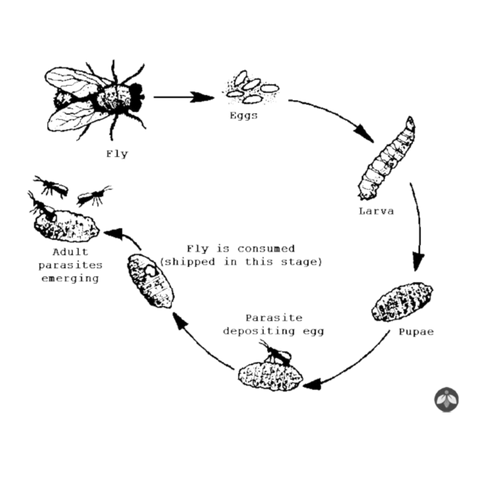Fly parasites are very small, harmless insects that can survive only by attacking and killing the immature pupal stage of flies. They kill the fly before it becomes an adult. Fly parasites will kill most species of flies normally present in animal manure, decaying feed, hay and garbage. Flies have the ability to produce more eggs, produce a new generation in a much shorter period of time and travel much greater distances than fly parasites. For this reason it is best to release small amounts of fly parasites throughout the fly season instead of just one large release. This keeps a constant level of fly parasites in the manure where flies are continually breeding.
The fly parasites are shipped, still developing inside the host fly pupae, packed in a bag mixed with wood shavings for protection. Depending on temperatures during shipment, parasites will start to hatch within 2 to 5 days after they arrive. Warmer temperatures will make them hatch sooner (85°F). DO NOT leave them in direct sunlight or intense heat. Cooler temperatures will slow them down (below 85°F). We do not recommend refrigeration. DO NOT FREEZE.
The best time to start releasing the parasites is when some have begun to hatch in the bag. Keep the bag closed and in a warm place, out of direct sunlight, until you notice some parasites walking around inside. The fly parasites have wings and even thought they aren't strong fliers, they will flit form place to place. They can travel about 100 yards in search of fly pupae and will burrow into the manure. Simply sprinkle them out of the bag or throw them by hand onto the manure. Once hatched they will immediately search for fresh pupae in which to lay their eggs. The female parasites will lay up to 50 eggs during her lifetime, which lasts, depending on temperature, from two to three weeks.
Even though they are shipped in an easy to handle, immature stage, they must be put where they will survive long enough to hatch and go to work. Release fly parasites in all manure areas: inside barns, stalls, paddock areas, feed bunks and loafing areas. Along fence lines and corral posts. Around the perimeter of manure piles, pits, or bins. Also release around water troughs, rotting hay and feed, compost piles, drainage sites, kennels and any other sites where livestock droppings accumulate. Do not release the parasites all in one spot. Sprinkle them sparsely over the entire fly-breeding area. Avoid direct sun, pooled water and pesticide soaked areas. If direct sunlight, ants, wild birds or chickens are a problem, cover the pupae with dirt or organic matter. A major benefit of this program is how easy fly parasites are to use. No equipment, no mixing, no long drawn-out process and no feed additives.
Even though you may be controlling fly breeding at your facility, flies may be attracted from other areas. These are called migrating adult flies. The use of fly baits and traps can help considerably in controlling these migrating flies. Poison baits will not hurt the parasites unless they are put directly in the manure. Residual sprays may also be used on structures where flies rest. BE CAREFUL! Using pesticide sprays to kill adult flies close to parasite release sites may kill the parasites as well. Flies are able to develop resistance to chemical sprays very quickly so be selective and use caution.

